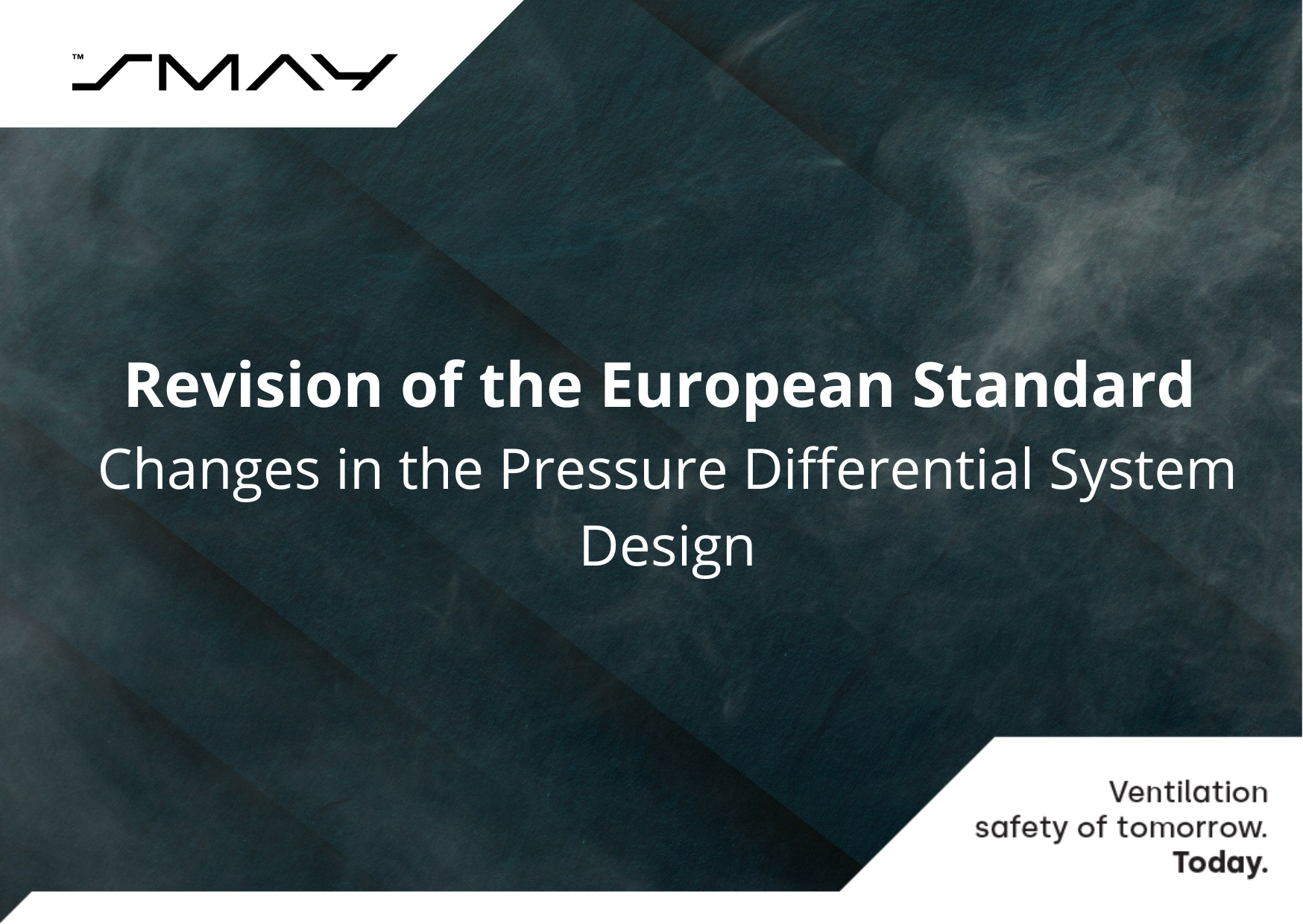Revision of the European Standard – Changes in the Pressure Differential System Design

It’s here already! Of course, we are talking about the revision of the European standard PN-EN 12101-6 for the design of pressure differential systems, which since 2022, has been replaced with the following two standards: PN-EN 12101-6:2022 and PN-EN 12101-13:2022. What will change in the design of pressure differential systems?
The update had been discussed but no one had seen it. Many people doubted that it would ever happen and suddenly here it is – and not just one but two standards! This article presents substantial changes being introduced in the new standards.
New standard PN-EN 12101-6:2022 – Profile
This standard focuses on the devices being used in the construction of pressure differential systems. It determines the components of device kits, how to divide them into families and what tests should be carried out on individual kits. The goal of these tests is to prove that a given device kit can create the required level of overpressure, as well as directional airflow from the space protected with overpressure to the adjacent space. Ventilation systems designed in accordance with PN-EN 12101-13 should consist of components tested in accordance with PN-EN 12101-6, which meet requirements of this standard.
Testing of the devices being used in the construction of pressure differential systems
The tests that should be carried out on the device kits are listed below as follows:
• Functional test – simulates the alternating opening and closing of the doors to a protected space. The following parameters are tested during the test: pressure stabilisation time at the required level after the door has closed and the time necessary to reach at least 90% of the assumed efficiency after the door has opened. The test is carried out for 20 open/close cycles. The times necessary to reach the assumed parameters may not exceed three seconds for any repetition.
• Durability test – during this test, the door to the test space is opened and closed alternately 10,000 times. The goal of this test it to prove the durability of the kit being tested and it does not require any measurement of time necessary for the system to reach the assumed parameters.
• Second reliability test – this functional test is repeated after the durability test.
• Oscillatory test – this test checks the resistance of the kit being tested with respect to the conditions of uneven opening and closing of doors.
Division of the device kits in accordance with the standard
The standard divides the device sets into three basic groups, depending on the solution to be applied to the overpressure control in the protected space by means of the following:
1. a barometric damper;
2. a damper working with the pressure regulator and sensor;
3. and pressure sensors, regulators and frequency converters.
New standard PN-EN 12101-13:2022 – Profile
PN-EN 12101-13:2022 includes guidelines for the design of pressure differential systems. The fundamentals have not changed, in that it is still necessary to supply air to the protected space in order to create overpressure and it is still necessary to vent off the air from the storey engulfed in fire. What is important though, is that the standard allows for the design of overpressure systems only. Systems based on underpressure have been removed.
Establishing the airflow path in accordance with PN-EN 12101-13:2022
The standard emphasises the establishment of the airflow path. It is necessary to define the external air intake points, the points where the air flows inside a building and the point where the air is being vented out of the building. While the “old” version of the standard included similar requirements, the “new” one describes this problem more precisely.
The change in the number of system classes
In the “old” version of the standard, there were six system classes delineated with the letters A to F. A large number of classes meant that it was often difficult to assign a building to a particular class. There are only two classes in the “new” standard: A and B systems.
Parameters such as the minimum pressure difference required for opening a door or airflow velocity in an open evacuation door have been defined for both system classes. New criterion values are shown in Table 1 below.
Criterion values introduced in the revision
Table 1. Functional parameters of class A and class B pressure differential systems
| Parameter | Class 1 | Class 2 |
| Door opening force | < 100 N | |
| Pressure difference | min. 30 Pa | |
| Airflow velocity in open doors – minimum | 1 m/s | 2 m/s |
| Activation time | 60 s | |
| Operating time | 120 s | |
| Response time | 5 s | |
As can be seen from the table above, one of the new criteria is the response time of the pressure differential system, which should be measured during commissioning. In addition, the requirement to maintain 10 Pa within the staircases when the end door was open, has also been removed from the standard, which significantly increased the air streams required for the system. It is also worth mentioning that the standard introduces a 30 Pa minimum overpressure level for all protected spaces, which means both the staircases and atria (if present).
Establishing the air stream and leakage area in accordance with the new standard
The air stream that should be supplied to the staircase or the lift/elevator shaft, according to the new standard, is established just as in the previous version of the standard, namely, the air stream necessary for the pressure criterion and the air stream necessary for the flow criterion should be determined and then the greater one should be selected.
Some interesting changes have been introduced in establishing the leakage area, which is the basis for determining the air stream necessary for the pressure criterion. The standard introduces additional leakage areas for lift/elevator shafts, which makes it possible to reduce the leakage areas of the doors of new elevator shafts and therefore decrease the air streams required.
Pressure differential systems in the design of high buildings
One of the significant issues in the new standard is the approach to the pressure differential system design for buildings with a height of at least 60 m. In such high buildings, additional factors might influence the parameters to be achieved by the pressure differential system, such as wind or the stack/chimney effect. Therefore, the systems serving high spaces require special attention and the standard has a requirement to conduct an additional pressure distribution analysis, as early as the design stage for such projects.
Numerical methods (CFD – Computational Fluid Dynamics) in the pressure differential system design
Numerical methods (CFD) are one of the tools that can be used in pressure differential system design. Without doubt, this is beneficial because it promotes more conscious design and helps to catch any mistakes at the design stage when it is easy to make any necessary changes.
The standard also recommends the placement of a sign near the entry of a staircase at firefighter access level which displays the information that the staircase is protected by the pressure differential system. It should be the graphical symbol that is shown in the standard.
Summary
The most important changes introduced in the new standards are described above, however, there are many more changes. It would be impossible to describe them all in a single article, so we will surely publish more information on this subject in the future.




